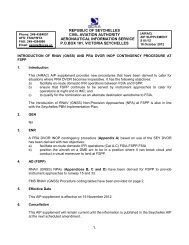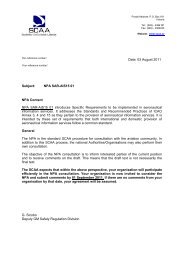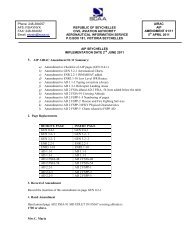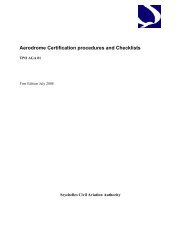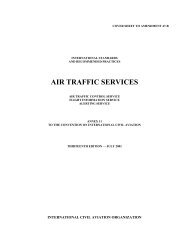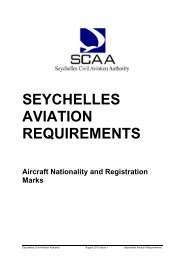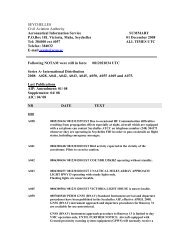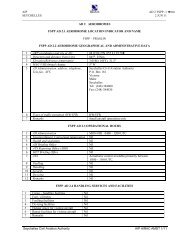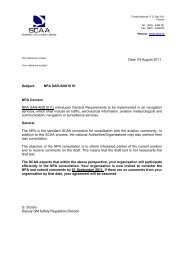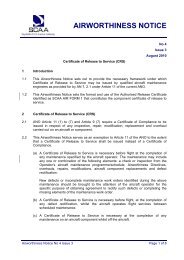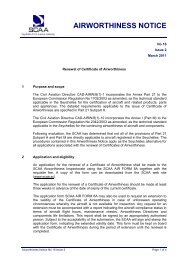FLIGHT OPERATIONS - SCAA
FLIGHT OPERATIONS - SCAA
FLIGHT OPERATIONS - SCAA
You also want an ePaper? Increase the reach of your titles
YUMPU automatically turns print PDFs into web optimized ePapers that Google loves.
SAFETY REGULATION<br />
<strong>FLIGHT</strong> <strong>OPERATIONS</strong><br />
<strong>FLIGHT</strong> <strong>OPERATIONS</strong> DIRECTIVES<br />
2/2007<br />
Applicability:<br />
All Aeroplane AOC Holders<br />
Extended Twin Engine Operations (ETOPS)<br />
1. ETOPS Dispatch requirements<br />
1.1 The Authority would like to clarify and confirm the interpretation and application of<br />
ETOPS dispatch requirements.<br />
1.2 ETOPS dispatch requirements shall be completed prior to departure on a flight<br />
where ETOPS operations will be conducted at any point during the flight. For the<br />
purpose of ETOPS dispatch requirements, the flight shall be deemed to be an<br />
ETOPS flight on departure (at the commencement of such flight).<br />
1.3 JAA GAI-20 Section 10 (d) (5) states:<br />
“An aeroplane should not depart on an extended range operation unless the<br />
required take-off, destination and alternate aerodromes, including suitable en-route<br />
alternate aerodromes, to be used in the event of propulsion system failure or<br />
aeroplane system failure(s) which require a diversion, are listed in the cockpit<br />
documentation (e.g. computerised flight plan). Suitable en-route alternates should<br />
also be identified and listed in operational flight plan for all cases where the planned<br />
route of flight contains a point more than one hour flying time at the one-engineinoperative<br />
speed from an adequate aerodrome. Since these suitable en-route<br />
alternates serve a different purpose than the destination alternate aerodrome and<br />
would normally be used only in the event of an engine failure or the loss of primary<br />
aeroplane systems, an aerodrome should not be listed as a suitable en-route<br />
alternate unless:<br />
….<br />
(iii) The latest available forecast weather conditions for a period commencing one<br />
hour before the established earliest time of landing and ending one hour after the<br />
established latest time of landing at that aerodrome, equals or exceeds the<br />
authorised weather minima for en-route alternate aerodromes in Appendix 3. In<br />
addition, for the same period, the forecast crosswind component, including gusts,<br />
for the landing runway expected to be used should not exceed the maximum<br />
permitted crosswind for single engine landing taking into account the runway<br />
condition (dry, wet or contaminated).<br />
….”<br />
Recipients of new FODs are asked to ensure that these are copied to their 'in house' or contracted<br />
organisations, to relevant outside contractors, and to all members of their staff who could have an interest in<br />
the information or who need to take appropriate action in response to this Compliance Policy.
2. ETOPS Entry Point (EEP) Requirements<br />
2.1 The Authority would like to clarify and confirm the interpretation and application of<br />
weather assessment prior to entering the EEP.<br />
2.2 The legal requirement is to obtain and assess a weather forecast (TAF) for the<br />
relevant ETOPS alternate aerodrome. This may be supplemented by the relevant<br />
weather report (METAR) to the extent that the period of validity is consistent with 1<br />
hour prior to the earliest time of landing and one hour after the latest time of<br />
landing.<br />
2.3 JAA GAI-20 Section 10 (d) (5) states:<br />
“….<br />
(iv) During the course of the flight, the flight crew are to continue to remain informed<br />
of any significant changes in conditions at designated en-route alternates. Prior to<br />
proceeding beyond the extended range entry point, the forecast weather for the<br />
time periods established in paragraph 10.d.(5)(iii), aeroplane status, fuel remaining,<br />
runway surface conditions, landing distances and aerodrome services and facilities<br />
at designated en-route alternates should be evaluated. If any conditions are<br />
identified (such as weather forecast below landing minima) which would preclude<br />
safe approach and landing, then the pilot should take an appropriate course of<br />
action.….”<br />
2.4 The Authority is aware of current difficulties in obtaining the required weather<br />
product. Certain services providers are claiming that they do not have access to<br />
such weather products. This is being addressed with the Authorities concerned.<br />
This should not prevent flight crew from seeking the relevant weather product.<br />
3. Industry Application<br />
3.1 The Authority would also like to confirm that the above is consistent with those rules<br />
and standards as applied by the UK CAA under the previous CAP 513 and the FAA<br />
under AC 120-42A.<br />
4. Queries<br />
4.1 Any queries as a result of this compliance policy should be addressed to Head of<br />
Flight Operations at the following e-mail address: morr@scaa.sc<br />
5. Cancellation<br />
Nil<br />
Marlon A. Orr<br />
Head Flight Operations<br />
2 nd April 2007<br />
Recipients of new FODs are asked to ensure that these are copied to their 'in house' or contracted<br />
organisations, to relevant outside contractors, and to all members of their staff who could have an interest in<br />
the information or who need to take appropriate action in response to this Compliance Policy.




